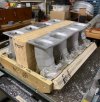Terry Oxandale
Skinny Man
Andrew, based on my experience (homebuilt IR/ITB setup using the Holley self-learn, I would push back at least on the initial bullet point. I run speed density on mine (48mm) with highly progressive throttle geometry, and find it VERY streetable, and obviously trackable. Currently using a stage 2 Livernoise cam, so it's not close to stock, has a little chop, and works great. Throttle response is excellent. This LS1 has 554 HP/517 ft/lbs. The tuner guys thought I was making a big mistake not going to alpha-N, but once it was on the dyno for tuning, they changed their minds. I do run eight vacuum signals (one from each runner) to a common plenum (the bellcrank mounting column) for the vacuum signal, with TPS, temp, WBO2, and RPM being other inputs. Works very well. I personally feel that any ITB set-up will always have personal modifications that must be made to them to make any of them work perfect. "Bolt-on" is a myth to me, but I'm sure the VERY expensive ones are not. I am currently repeating this project with a new LS3 using a rectangular port intake (bored LS3). BTW, thanks for your great insight and post!Hi all,
I have put a lot of effort into setting up and fine tuning a Speedmaster budget 8 stack for the street on a cammed LS3. It runs pretty good. There are a few things relevant to this discussion.
- IR intakes do not produce a MAP signal that is properly representative of engine load unless they have a large common plenum, so normal speed density tuning does not work very well. Fueling as a function of throttle position is the standard approach with IR intakes - usually referred to as Alpha-N fueling.
- The fueling requirements change significantly for very small changes in throttle position from idle through to cruise, so they are fussy to tune down low, the fuel table requires heaps of resolution for the first 10% or so of throttle opening, and it's not feasible for this part of the fuel table to be self learning in my experience.
- Linkage quality and precise set-up is really important. I had to throw away or modify this area of the Speedmaster set-up, whereas the Hilborn EFI on my race car is excellent in build-quality and close tolerances by comparison. I think the Hilborn will be great on the street if you physically set it properly.
- If you run Hilborn, you might be best to use dual WBO2s (one in each bank) or one WBO2 that can see both banks (like in an "X" pipe) for closed loop mixture control in cruise conditions that use the whole engine average, because the Hilborn butterflies open in different directions bank to bank with reference to the port and injector position due to the cross-link vs capstan linkage. I don't think that's a biggie though.
In summary, in going the IR route on a healthy engine, you are signing up for an extensive tuning and set-up process, but the results will be excellent if you get it right. It is unlikely you'll get there sticking with speed density tuning and auto-learning using a wizard style approach.
Cheers, Andrew
Attachments
Last edited:



